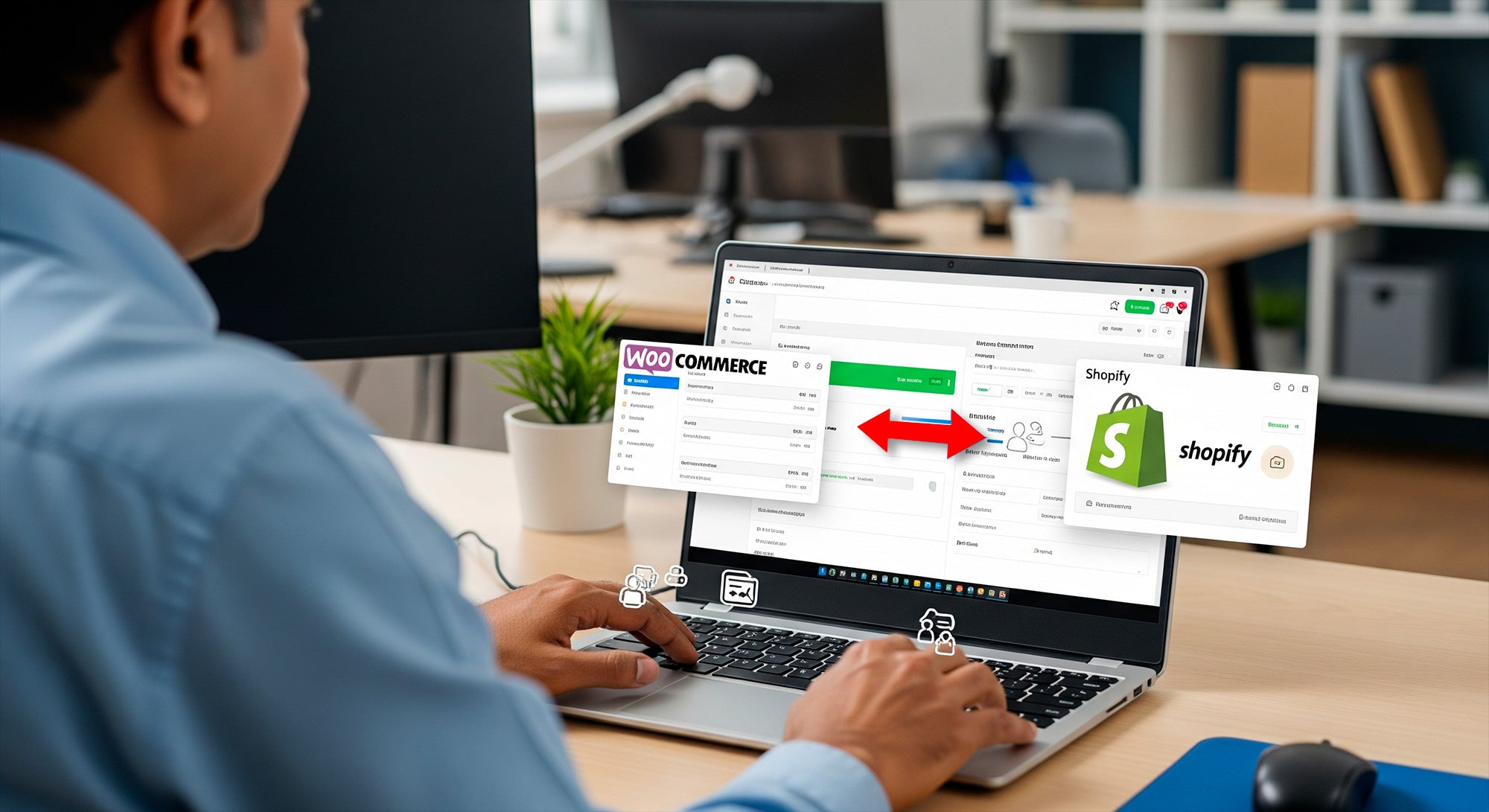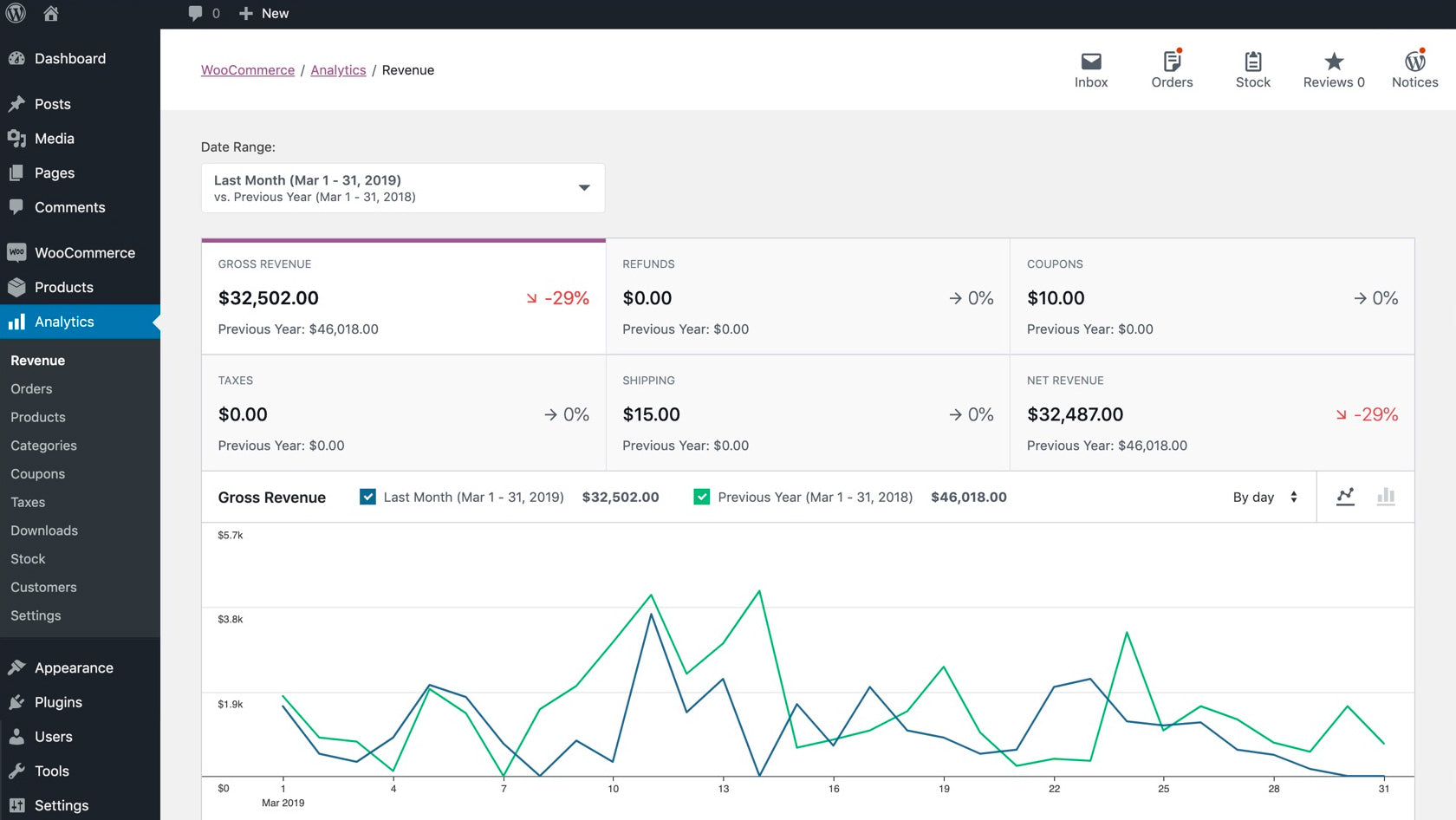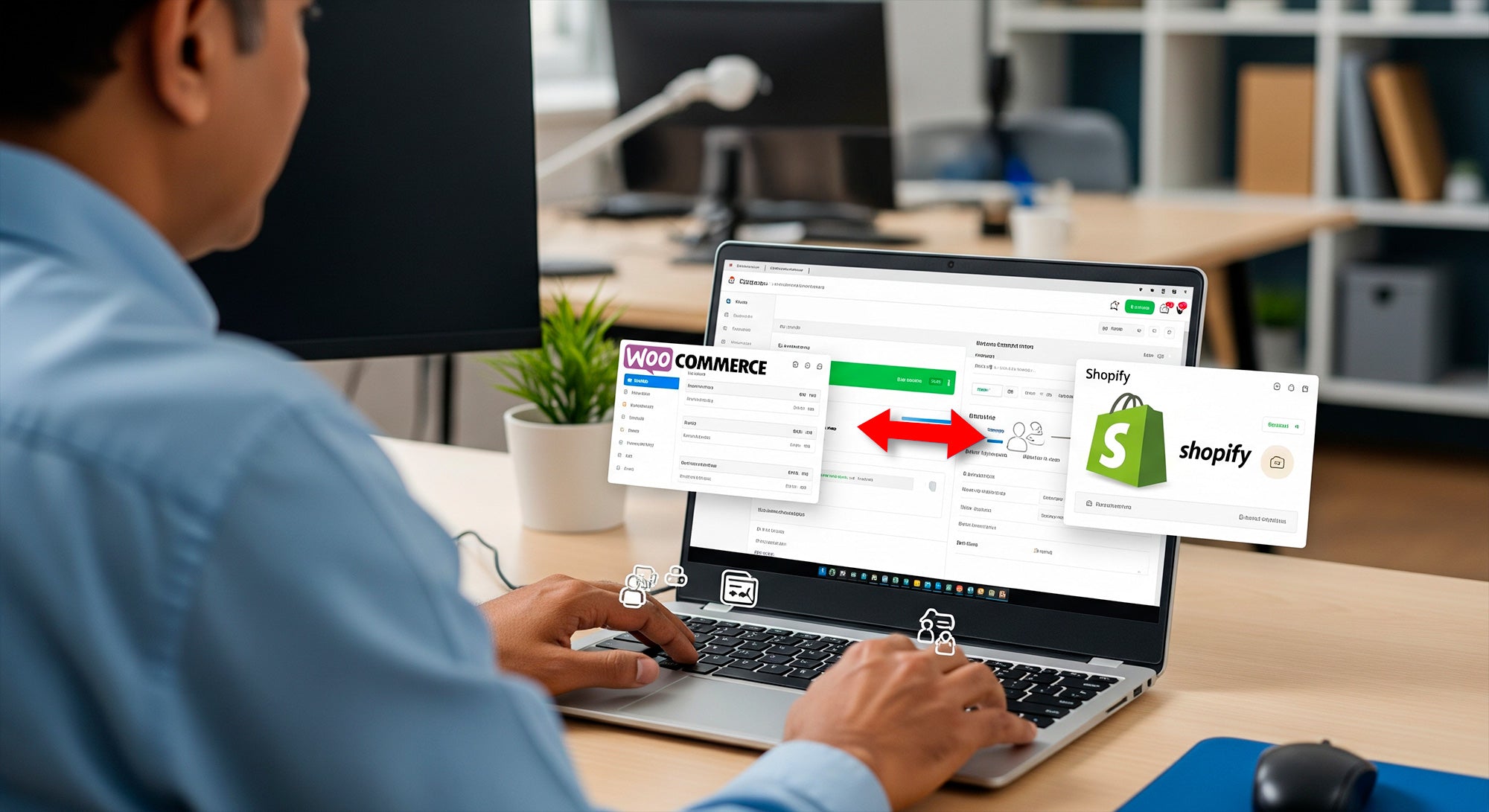Migrating Woocommerce to Shopify
What to expect when moving your ecommerce site from Woocommerce to Shopify in 2025

Why should you migrate from Woocommerce to Shopify?
If you're considering moving your ecommerce site from WooCommerce to Shopify, you're not alone. WooCommerce is an easy starting point, but once you have more complex needs it quickly falls short. It doesn’t make sense to invest in a platform that can’t scale with your ecommerce business. If this sounds like your experience with WooCommerce, it may be time to reassess your platform.
A lot of merchants have made the switch to Shopify in recent years as their businesses grew beyond what WooCommerce can support. To stay competitive in online selling, you need powerful features to scale your order management, inventory synchronization, marketing services, API integration, B2B needs and more. Unfortunately, many store owners feel that WooCommerce is not keeping up with these features. This is causing an exodus from the platform.
Switching ecommerce platforms is never a quick or simple decision. It impacts every part of your business, including your team and customers. If you are going to make the switch, you need to feel confident in your new solution. Shopify offers a more streamlined, fully hosted experience that removes the need for constant technical oversight, while giving you the tools to grow. If you're looking for better reliability, performance and flexibility, it's time to take a look at migrating from WooCommerce to Shopify.

What’s wrong with WooCommerce?
You’re probably thinking to yourself, “WooCommerce has been around for a long time, is it really that bad?” Let’s take a deeper look at WooCommerce and see if we can answer that question.
Merchants need ecommerce tools that are fast, flexible and easy to scale. One common complaint of WooCommerce is that it struggles to keep pace and becomes a patchwork of plugins and code-hacks that slow down your store instead of helping you grow. But why does WooCommerce have these issues in the first place? You might be surprised to know it wasn’t designed for ecommerce at all.
WooCommerce wasn’t built as a standalone ecommerce solution, it’s a plugin layered onto WordPress. WordPress is famously known as a blogging platform, not an ecommerce retail service. Obviously an ecommerce store has way more requirements than a simple blog, so WooCommerce is lacking power at its core.
In any given ecommerce work day, you need to juggle product catalogs, sync inventory, manage sales channels, run in-person retail, or work on automated marketing emails and segments. That’s a lot of specialized features that need well thought out implementations. None of that is native to WooCommerce so you’ll have to rely on third party apps to make your store function. Okay, so what’s so bad about installing a bunch of plugins? Each of these plugins introduce its own updates, code dependencies and potential for conflicts. And we all know that too many plug-ins can slow site performance. On top of that, with WooCommerce you're responsible for your own management of those plugins, testing and updates. Hopefully you have an IT degree in addition to running your business. It’s starting to seem like WooCommerce can become more of a burden than a benefit for growing merchants.
To make things easier, let’s outline some common pain points WooCommerce users face, and how Shopify solves them:
Plugin Dependency Creates Chaos
WooCommerce relies on dozens of third-party plugins to deliver basic functionality like SEO, shipping rules, and backups. This means every update is a gamble on third-party services. Installing one plugin can break another. Shopify eliminates that chaos by offering built-in functionality that is tested to work across the entire platform. Fewer third-party services mean less problems and more uptime.
Site Speed Suffers Under WordPress Bloat
Because WooCommerce runs on WordPress, performance can take a hit as more features and content are added. WordPress was originally designed for blogging, not high-performance retail. Slow load times hurt SEO and conversions. A delay of even one second in load time can reduce conversion rates by up to 7%, and Google uses site speed as a key factor in search rankings. Shopify’s hosted infrastructure is optimized for ecommerce speed, keeping your site fast even as you grow.
Checkout Friction Hurts Conversions
WooCommerce’s checkout process is often known to have trouble loading. This of course, is the last page where you want problems. If customers can’t checkout, then you can’t make money. The WooCommerce checkout pages are very susceptible to theme and plugin conflicts. Shopify’s native checkout is one of the most optimized on the market, reducing cart abandonment and increasing completed orders. The entire checkout process in Shopify is protected from third-party conflicts and ensures availability.
Security and Compliance Are on Your Shoulders
With WooCommerce, you’re responsible for PCI compliance, SSL certificates, plugin security, and backups. That’s a lot to manage. You’re responsible for keeping the platform and plugins up-to-date. Old software is the number one vulnerability that sites face. Hackers and scammers prey on outdated security tactics and code. Cyber criminals have repositories of known vulnerabilities in old versions, so out-of-date stores are easy targets. So why deal with this headache when Shopify handles all of this out of the box, giving you enterprise-grade security without the overhead. Shopify’s infrastructure is certified Level 1 PCI DSS compliant, which means your customers’ data is secure without you lifting a finger.
Scaling Becomes a Technical ProjectIf you want to add more stores, launch international versions, or unify POS and ecommerce, WooCommerce requires custom development and multiple instances. Shopify Plus features native support for multi-store management, POS integration, and localization.

Why More Merchants Choose Shopify over WooCommerce
Now that we have some idea why WooCommerce isn’t the best choice, let’s dive into Shopify and see how it solves the most common pain points that arise when running an ecommerce store. Let’s start with the Shopify platform itself.
Shopify is a fully hosted, cloud-based platform. You don’t have to worry about managing servers, updates, or security patches. That alone removes a significant technical burden that many WooCommerce merchants face. With Shopify, all server maintenance, software updates, and security patches are handled behind the scenes, automatically. You never have to think about things like updating PHP versions, setting up SSL certificates, or patching vulnerabilities in WordPress plugins.
Shopify also simplifies third-party dependency by offering built-in features for inventory management, shipping, taxes, and reporting. You don’t have to rely on third-party developers to make your store function correctly. You can expect fewer compatibility issues, less troubleshooting and a more reliable store experience overall.
Shopify also comes equipped with ancillary tools that help your ecommerce sales. These tools cover essential marketing functions like customer segmentation, email marketing, automation and performance analytics. You can access these features within your Shopify Admin, giving you more control over how you engage with your customers. You can also sync with Klaviyo, Mailchimp or any other popular email service, but it’s nice to know you can do it all from Shopify if you want.
Basically, Shopify is built from the ground up for commerce. That means faster performance, better support and a cleaner user experience for both customers and staff. And if you want some fancy stats to back up that those claims, here is what you get when you switch to Shopify:
- 99.9% uptime and enterprise-grade security built in
- 36% better total cost of ownership (TCO) compared to WooCommerce
- 17% higher average checkout conversion rate
- Powerful built-in features like multicurrency support, B2B tools, advanced SEO, and POS integration
- Global scalability with tools for localization, payments, and international expansion
- Unified commerce for online, in-store and social commerce.
- SOC, GDPR, and PCI compliance handled for you
Merchants move to Shopify because it takes the complexity out of running an online store. It eliminates the technical headaches of WooCommerce and brings your tools under one platform. Shopify offers a simpler path forward that lets you focus on selling and scaling.

It’s Time to Migrate to Shopify
Brands choose Shopify because it simply works better for the needs of modern ecommerce. It’s built to support businesses that are ready to scale, streamline operations and meet rising customer expectations. For businesses that have started with WooCommerce and now find themselves limited by the platform’s technical demands or fragmented plugin environment, Shopify offers a cleaner, more scalable alternative.
At Sunrise Integration, we specialize in helping brands make that leap. We work closely with you to manage the entire WooCommerce to Shopify migration process, starting with discovery and strategy sessions to understand your current setup, data structures, and business goals. From there, we migrate your products, customers, order history, theme customizations, and integrations. But our support doesn’t end at launch. We continue working with you post-migration to fine-tune performance, enhance marketing workflows, and integrate additional tools to help you get the most out of the Shopify ecosystem.
If you’ve started to feel the growing pains of WooCommerce this is your opportunity to move to a platform built for scale. Shopify is ready to support your next phase of growth, and we’re here to guide you through it. Contact us now if you're ready to make the move!



